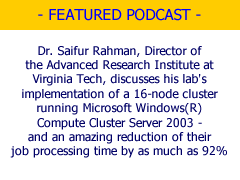As bioinformatics becomes an indispensable tool for performing advanced research into the origins and treatment of disease, more labs, both commercial and non-commercial, are investing in high performance computing platforms to help speed drug discovery. The Computational Bioinformatics and Bioimaging Laboratory (CBIL) at Virginia Tech is one such organization. The lab is hosted by the school's Advanced Research Institute (ARI), a group devoted to multidisciplinary scientific research.
CBIL is also a participant of the cancer Biomedical Informatics Grid, or caBIG (http://cabig.nci.nih.gov), which is a voluntary network connecting individuals and institutions to enable the sharing of data and tools, creating a World Wide Web of cancer research. The caBIG software platform enables U.S. cancer researchers to analyze their molecular expression data and provides the research community access to a federated Grid of informatics tools. The Grid also provide access to data from the whole community, allowing for more comprehensive research. The goal is to speed the delivery of innovative approaches for the prevention and treatment of cancer.
CBIL represents one of the emerging trends in medical research — that of the specialized bioinformatics provider. Virginia Tech does not have a medical university, so CBIL partners with other institutions such as Georgetown Medical Center, Johns Hopkins University, NIH and local hospitals. These institutions offer their medical resources and raw data, while CBIL provides the computer and bioinformatics expertise to extract useful knowledge from that data.
Research at CBIL focuses on data modeling and molecular analysis of diseases such as cancer (breast, prostate and ovarian), muscular dystrophy and cardiovascular diseases. The lab performs a technique called “molecular classification” to qualify various diseases. This is accomplished by applying large-scale computational techniques to identify biomolecular markers associated with a disease state. The research allows scientists to determine how specific drugs affect those markers.
“We hope that over time these markers will serve as indicators for diagnosis as well as prognosis, which will help in drug discovery and novel therapies,” says Dr. Saifur Rahman, director of the Advanced Research Institute. “And if we are successful in getting better drug discovery, we'll be able to treat a wider variety of cancers — hopefully more efficiently.”
According to Dr. Rahman, the technology that has made this type of medical research possible has really just emerged in the last five to ten years. He says there are three technologies that are fundamental to this new model:
- Personalized Molecular Profiling: Based on their genetic makeup, their physical condition and their environment, individuals are affected by diseases differently and respond differently to identical therapies. The profiling strategy is to identify disease subtypes within a heterogenous disease type. This will help to enable personalized drug therapies to be developed.
- Computational Systems Biology: Computer modeling and simulation is being used to replace laboratory experiments. By replacing physical experimentation with virtual experiments, a much wider range of “what if” investigations can be attempted. This technology is especially useful in trying to identify the most likely disease pathways.
- Biomedicial Imaging: Advanced visualization is providing a powerful tool for in vitro disease detection and diagnosis.
At CBIL the computing infrastructure that supports this work consists of a 16-node HP cluster, running Microsoft's Windows Compute Cluster Server (CCS) 2003 as the cluster management platform. The lab was one of the early adopters of CCS, which was released for general availability in August of 2006. Prior to the cluster solution, CBIL ran the bioinformatics applications on several single-node servers, distributing the jobs across them. According to Dr. Rahman, this required much more prep time, since it involved dividing the computational work into pieces and then reconstructing them after the results were obtained.
The server cluster enabled a more efficient computational model. CBIL recognized an 85 to 90 percent reduction in run times on two key applications, the Robust Biomarker Discovery and Predictor Performance Estimation, when compared to the single-node server set-up. In addition, the use of CCS allowed the researchers to remain in the familiar Windows environment, allowing for a comfortable transition to a parallel computing platform.
The advanced technology being used at CBIL provides a new model for medical research. In contrast to monolithic “magic bullet” approaches to cancer and other life-threatening diseases, molecular classification provides a discovery pathway for truly personalized medicine. The ability to qualify differences in drug responses on an individual basis will make it possible to find more effective drugs treatments. And the use of high performance computing is enabling this research to progress at a much faster rate than ever before.
“HPC will allow us to analyze more closely and in finer detail such patient responses to different drug regimes,” explains Dr. Rahman. “But the challenge will still remain as to how we interpret the data we get from our high performance computers.”
—–
To hear the whole story behind the Computational Bioinformatics and Bioimaging Laboratory research work, listen to our HPCwire podcast interview with Dr. Saifur Rahman at http://www.taborcommunications.com/hpcwire/podcasts/microsoft/index.html. For additional background information about the lab, visit http://www.cbil.ece.vt.edu/.




























































